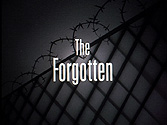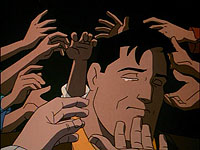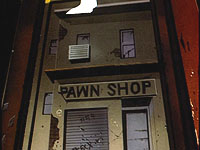|
||
|
| Credits | Cast | |
Written by Jules Dennis, Richard Mueller & Sean Catherine Derek Directed by Boyd Kirkland Music by Shirley Walker Animation by Dong Yang |
Kevin Conroy as Bruce Wayne Efrem Zimbalist, Jr. as Alfred Richard Moll as Computer Lorin Dreyfuss as Salvo |
Dorian Harewood as Dan Riley George Murdock as Boss Biggis Jay Thomas as Guard #1 Ian Patrick Williams as Ivan |
|
I say this: By causation or coincidence, there is not one single good episode of Batman: The Animated Series that has Sean Catherine Derek's name on it. The evidence for this sour claim? “The Cat and the Claw,” “Cat Scratch Fever,” “Nothing to Fear,” “P.O.V.”, “Prophecy of Doom.” And “The Forgotten.” In Batman Animated, Paul Dini reports that Derek (the series’ first story editor) had a sensibility out of step with that of Timm and co-producer Eric Radomski: “While [they] were pushing for gritty action stories, Sean lobbied for Batman to help the homeless and install a recycling bin in the Batcave.” I don’t remember whether the recycling bin ever made it in, but the homeless angle did. The result is the one episode of BTAS that I wish I could forget. Dereks’ metier, apparently, was social comment. Now, there’s nothing wrong with social comment per se, and such “gritty action” noir eps as “It’s Never Too Late,” “Robin’s Reckoning,” and even “Paging the Crime Doctor” show how far an animated series can handle it competently. The trick is to ape the “problem melodramas” that Warner Bros. churned out in the 30s and 40s--those pictures that had Cagney and Robinson, Davis and Bogart, Muni and Raft snarling at crime, unemployment, and racism. But each of these “ripped from the headlines” stories was hung on a tight, economical story of conflict and brutality. They were unhappy tales of vulnerable men beaten down and destroyed by a godless, mindless, inhumane society.
They are also sharply at odds stylistically and philosophically with the rest of the series. BTAS consistently eschews the general for the particular. Batman executes his war on crime on a case-by-case basis. Yes, he helps out with charities and government projects. But that’s as Bruce Wayne. As Batman, he takes on individuals, sometimes ruthlessly and sometimes with charity and understanding. He does not battle for the soul of Gotham. He battles for the soul of each Gothamite. That insistence on the primacy of the individual is echoed in the show’s preference for psychological exploration and detail. The stories of Victor Frieze and Jervis Tetch move us because we recognize in their plight and in their responses motives and emotions that we feel in our own lives. Even the more monstrous psychos take off from real human emotions, quirks, and dilemmas. And Batman’s most fearsome and troublesome adversaries are twisted versions of himself. True, the baddies for the most part go unreformed. This is a very Calvinistic attitude, I’ve remarked, but that's also part of the show’s larger, very Protestant ethic: Society can take care of itself. God--or his agents--is interested in us.
The episode tries working up a little bit of self-exploration on Bruce’s part with a meant-to-be-stylish dream sequence that is depressingly literal and reveals nothing that we didn’t already know about him. Again, the series does better by contrasting Batman with his adversaries. It's not my place to condemn Derek, who is a writer with more than just Batman to her credit. Her take on the Dark Knight is an interesting one, and it's a pity that no one has--to my knowledge--gotten her account of her brief tenure on the series' writing staff. Still, her sins are those of sincerety and pedantry. And it's a point made implicitly in her own best work, "The Cat and the Claw": Behavior that would be admirable in one context is not admirable in all of them. The attitude of an activist and the needs of a good action cartoon do not serve each other well. |
|
Production Notes Boyd Kirkland: "There was a sequence at the beginning where Batman is wandering around the city, trying to find out why people were disappearing. It was staged with homeless people hanging around on sidewalks: families, mothers and kids. They made us take all that out of the boards. They said it was too much for kids to see that maybe a woman or a family can be out on the streets. They specifically asked that we only show men as homeless." |
|
Related Episodes |
What Others Are Saying ... |
| Back to Fire from Olympus |
Forward to Harlequinade |




